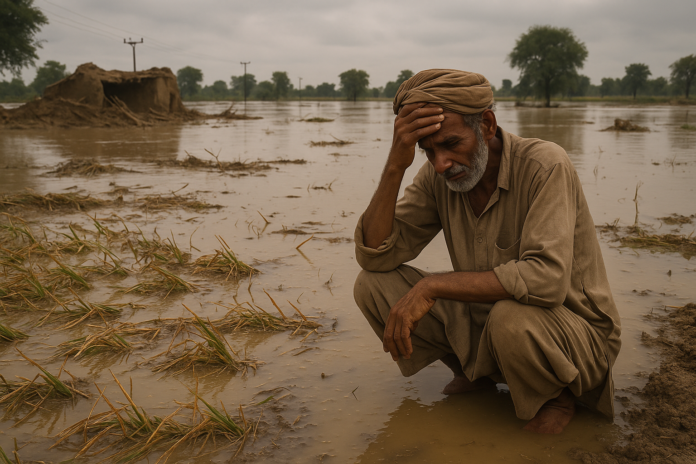
Lahore/Chiniot, September 1, 2025, 09:18 PM PKT — Devastating floods have ravaged Punjab’s fertile plains, leaving families desperate to rebuild after decades-worst flooding destroyed homes, crops, and livestock, as reported by affected residents. Muhammad Amjad, a 45-year-old farmer in Chiniot, mourned the loss of 13 of 15 acres, with rice and potato fields submerged, forcing women and children to evacuate while men guard remnants. The provincial disaster management authority reported over two million affected, 2,000+ inundated villages, 760,000 people and 516,000 animals evacuated, and 33 deaths in less than a week.
Amish Sultan, a 50-year-old farmer, lost his 10 buffaloes’ milk income (Rs100,000–150,000 monthly), while Mehdi Hassan, a 40-year-old laborer, saw his home washed away, now stranded roadside. Major dams near capacity and more rain forecast worsen the crisis. Agriculture experts warn of staggering losses in rice, sugarcane, maize, vegetables, and cotton, with Ibrahim Shafiq of Latif Rice Mills predicting rice prices to soar from Rs3,200–3,600 to Rs5,000–5,500 per 40kg, hurting local consumers and export competitiveness against India. Cotton losses threaten the textile sector, key to over 50% of exports, amid a 19% US tariff.
Farmdar and Zarai Mandi’s Ghasharib Shoukat highlight exponential damage to riverine farmland, risking wheat, vegetable, and cotton shortages, straining exports and budgets. With inflation cooling to 4.1% in July from 11.1% and food inflation from over 50% in 2023, August’s 4–5% projection may rise due to food shortages from delayed wheat sowing and cotton imports. In Lahore, 38-year-old rickshaw driver Aslam saved his livelihood from six feet of water, now in a relief tent amid a muddy camp city near the Ravi River, with 150–200 camps hosting 5–8 people each. Punjab authorities have set up 511 relief camps, 351 medical sites, and 321 veterinary facilities, evacuating 481,000 people and 405,000 animals, with 15,000 police deployed. Aamer Hayat Bhandara warns of billions in recovery costs and food insecurity if farmers lack support. Web context on flood impacts shows past neglect, while posts found on X reflect distress mixed with urgency—some demand aid, others blame policy failures. Critically, the narrative of “disaster response” may mask systemic vulnerabilities—web data hints at inadequate preparedness, and X sentiment suggests distrust in effective recovery, pointing to potential crises.

.jpg)




.jpg)
.jpg)


This website has been developed with good faith to create facilities for the people.Your ID Password and access to our website is for a specific period or temporary, it may be suspended at any time without telling any reason.Your ID Password or access does not create any your rights or liability onto owner of the website.
Office # 3-6, Ground Floor Idrees Chamber ,Talpur Road Karachi
info@taxhelplines.com.pk
+ 92 314-4062161
021-32462161
+ 92 305-2561915